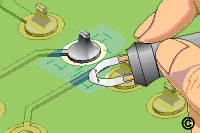No. 2.3.4
Coating Removal, Thermal Method
OUTLINE
This coating removal procedure uses a controlled, low temperature, localized
heating method for removing thick coatings by an overcuring or softening means..
CAUTION
Soldering irons should not be used for coating removal as their high operating
temperatures will cause the coatings to char and possibly delaminate the printed
board base material.
The use of thinned down soldering iron tips or soldering iron heated thin
cutting blades are not recommended since they do not provide controlled heating
and may present dangerous sharp edges to the workpiece surface.
To determine the appropriate coating removal procedure the coating must first
be identified. Refer to procedure number 2.3.1.
TOOLS & MATERIALS
Brushes
Heated Blade or Thermal Parting Tool
Hot Air Tool
Knife
Wood Sticks
PROCEDURE - THERMAL PARTING METHOD
- Select an appropriate thermal parting tip to suit the workpiece
configuration. Set the nominal tip temperature, using the manufacturer's
recommended procedure.
- Apply the thermal parting tip to the coating, using a light pressure. The
coating material will either soften or granulate. Polyurethanes will soften and
epoxies will granulate. The tip temperature should be regulated to a point where
it will effectively "break down" the coating without scorching or
charring. (See Figure 1).
- Gradually reduce the coating thickness around the component body without
contacting the board surface. Remove as much coating as possible from around
component leads to allow easy removal of the leads.
Clip leads of component parts that are known to be faulty, thus permitting
removal of the part body separately from leads and solder joints. Low pressure
air or a brush should be used to remove the loosened coating.
- Once sufficient coating has been removed, leaving only a small bonded joint
between the part body and printed board, heat the component body with the
thermal parting tool or hot air jet to weaken the bond beneath the component.
- Lift the component body free of the printed board using small pliers
NOTE
Twist the component prior to removal to shear any remaining epoxy bond to the
printed board surface.
- Once the component body has been removed from the board surface, the
remaining coating material can be removed by additional thermal parting. The
remaining leads and solder joints are then removed by appropriate solder
extraction means.
PROCEDURE - HOT AIR METHOD
By control of the gas/air temperature, flow rates and jet shape, the hot air
method can be applied to almost any workpiece configuration on both the
component and solder side of the printed board without damage. Extremely
delicate work can be handled in this manner while permitting direct observation
of the heating action.
- Set up the hot air tool per the manufacturer's instructions. Adjust flow
rate and temperature to suit specific coating removal application
CAUTION
Never set the gas/air temperature at a level that will cause scorching or
charring of the coating material or reflow the solder connections.
- Apply the heated air jet to work area. Apply light pressure using a wood
stick or other non marring tool to remove the softened or overcured coating. All
coating around individual leads, solder joints and component bodies can be
removed in this manner. (See Fig. 2).
- When the coating has been removed, use appropriate solder extraction method
to remove components if needed
EVALUATION
- Visual examination or UV light may be used to verify complete removal of
coating.
|
|
|
Solutions Across the Board
TM
|
|
|
|
Product Class: R/F/W/C
Skill Level: Advanced
Conformance Level: High
Revision: E
Revision Date: Jul 7, 2000
Repair Service Charge

Coating Removal Required At Outlined Area

Figure 1: Lightly apply thermal tip to coating to soften or granulate the
material.

Figure 2: Apply hot air to the work area and use a wood stick to remove the
overcured coating.

Figure 3: Removal complete.
|
Tricks of the Trade
This method is a good option to consider when the coating to be
removed is confined to small areas. You'll need to use a hot bar, blade style
heating tool as shown in figure 1 to control the temperature accurately. The hot
air method as shown in figure 2 is generally less effective. We recommend using
the Pace Pulse Heat LapFlo® Hot Bar Handpiece or Thermojet handpiece depending on the technique used.
|
|
|





